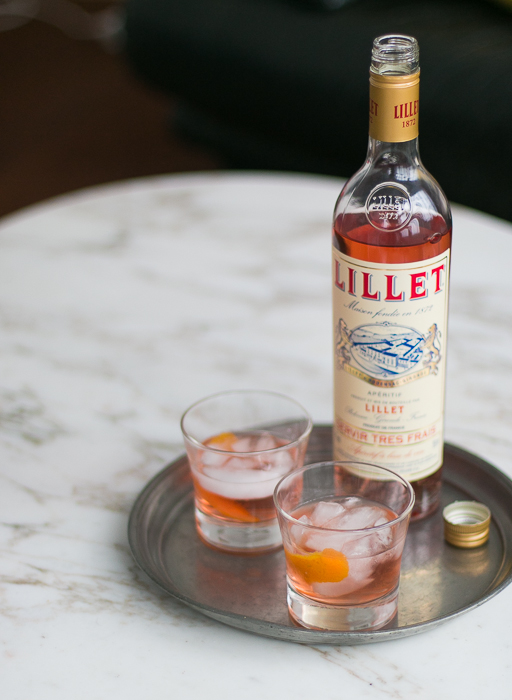I’m not sure how I discovered Lillet, an orange-infused apéritif wine, made in a town on a road between Sauternes and Bordeaux, but I remember driving through the area and making my friend screech to a halt when we (almost) passed the Lillet factory.
Factory probably isn’t the best word, but macerbatorium probably sounds a little dodgy, but when we walked in, we found ourselves in front of an astounding amount of oranges and shards of bark, bobbing up and down, as they macerated in vats of wine. While that was certainly a riveting sight, equally enticing was the silver daddy who was very easy on the eyes, who took us through the facility, explaining the process of making the famed apéritif wine, then joining us for a little dégustation.
It was hard to concentrate on the beverages clinking in our glasses, but I did my best. (I swear.) And I bought a bottle as a souvenir, likely as a pretext for letting us snap a picture of the two of us together, which had a hallowed place over my desk for well over a decade. I don’t know what happened to that picture, but I still pine for Lillet to this day. Interestingly, it’s rare that you find Lillet served in Paris and if you ask around, you’d be hard-pressed to find very many people in town that even know what it is. (Readers of The Sweet Life in Paris know what I was served the first time I tried to order it in a café, which I’m still living down.)
But Lillet has gained a strong following elsewhere in the world, and in a recent James Bond film, he ordered a Vesper, a cocktail crafted similar to a martini, with Lillet replacing the vermouth. So I was excited recently to see that Julhès, right smack-dab here in Paris, was offering a dégustation of all the Lillets, including the newer one, with rosé wine used as a base. When I got there, there were indeed a few bottles lined up on a cask, ready and waiting to be sampled, but no one was around to pour them. There was a fellow pouring tastes of red wine in glasses on another cask, next to the tempting line-up of Lillets, but he said he didn’t know anything about them.
When I asked at the counter, the two clerks didn’t know where the guy was either, and neither of them could tell me about the difference between the Lilletsnormaux, and the réserves, which I was especially eager to learn about, that is, to taste. (See? I told you no one is familiar with Lillet around here. And people think I make all this stuff up…) But I guess it’s time to join them in a way, because I left still not knowing the difference between the regular and the fancified réserve.
I decided just to buy a bottle of the Lillet rosé, and to heck with it. And even though the Lillet tasting turned out to be a bust for me, I was excited to find out that this very well-stocked épicerie (specialty food store) carries tortas de aceite, the wispy, crispy, crazy-good olive oil biscuits that I devoured in Seville. I did learn that the sesame sea salt version isn’t as good as the bitter orange ones that I had en Espagne. But at €2,90 (plus round-trip métro fare to the rue Faubourg Saint-Denis), buying the ones they had on hand was cheaper than a trip to Spain.
[The points of this story, so far, seem to be - 1) That you're never too old to learn new things, and 2) Back up your photos - not just your digital ones.]
Once home, I did my own little Lillet dégustation at my kitchen counter. I have to say, as much as I am a big fan of rosé, and Lillet, I’m not as fond of the rosy variety as I am of the classic white wine-based version of the apéritif. So I’ll have to go back to the store and get another bottle once I’m done with this one. Which will be soon, because the coming warm weather makes apéritif wines even more appealing. Almost as much as heading back to the tasting room near Bordeaux for some more hands-on Lillet-fueled action. And perhaps some replacement photos, too.
via:http://www.davidlebovitz.com/2014/04/lillet-french-aperitif/

No comments:
Post a Comment